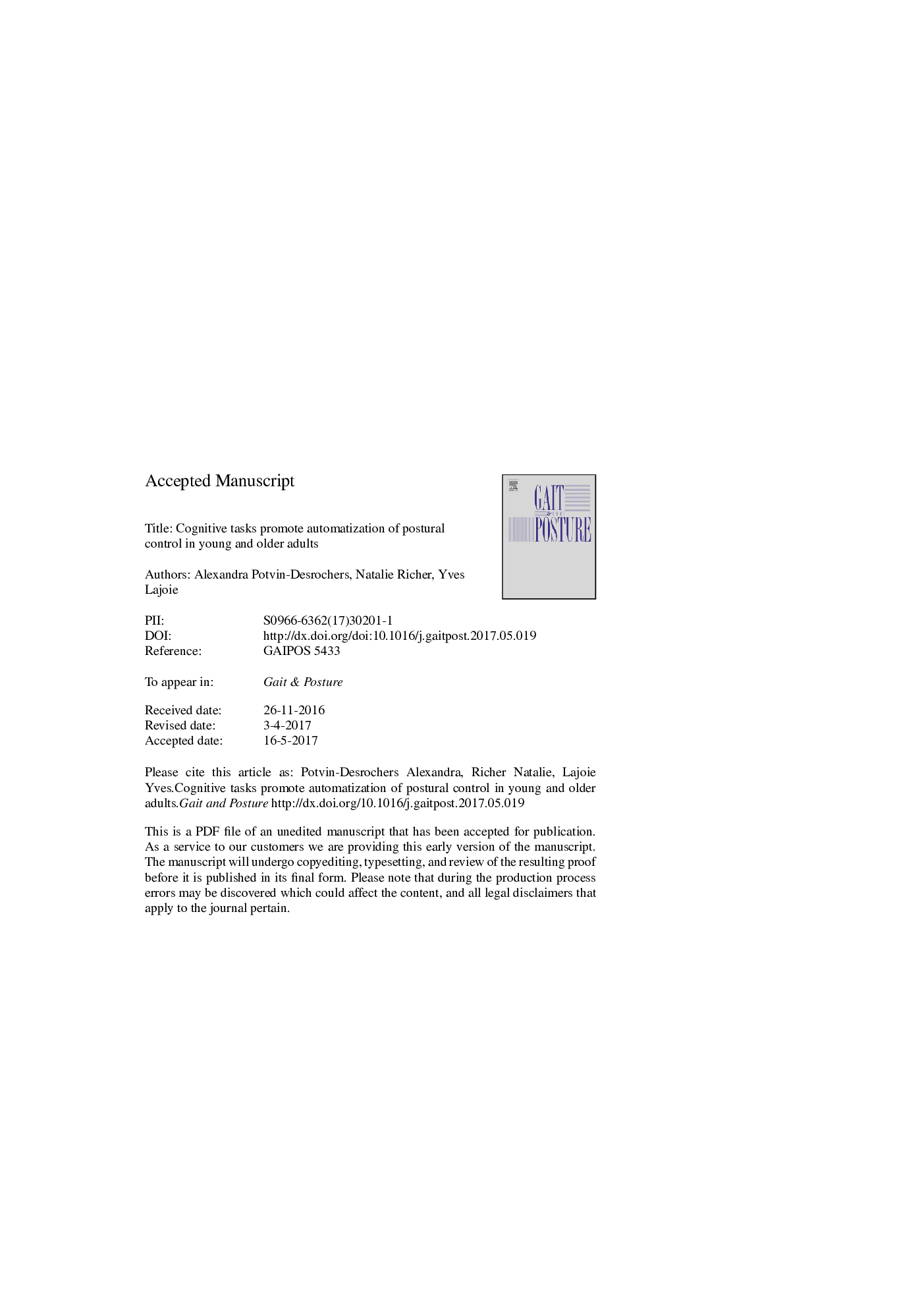| کد مقاله | کد نشریه | سال انتشار | مقاله انگلیسی | نسخه تمام متن |
|---|---|---|---|---|
| 5707800 | 1603838 | 2017 | 21 صفحه PDF | دانلود رایگان |
عنوان انگلیسی مقاله ISI
Cognitive tasks promote automatization of postural control in young and older adults
ترجمه فارسی عنوان
وظایف شناختی ترویج خودکار کنترل نظارت در جوانان و سالخوردگان است
دانلود مقاله + سفارش ترجمه
دانلود مقاله ISI انگلیسی
رایگان برای ایرانیان
کلمات کلیدی
کار دوگانه، کنترل پستی بزرگسالان سالمند، جوانان، آنتروپی نمونه
ترجمه چکیده
محققان با بررسی اثرات انجام وظیفه شناختی همزمان در کنترل عصبی در افراد جوان و سالخورده با استفاده از اقدامات سنتی مرکز فشار و اقدامات پیچیدگی، نتایج متضاد را در بر داشت. نتایج آزمایش هایی که نشان دهنده بهبود ثبات هستند، پیشنهاد استفاده از استراتژی هایی مانند خودکار سازی کنترل پاسکال یا استحکام کششی را پیشنهاد کرده اند. این آزمایش با هدف تایید در سالمندان جوان و سالخوردگان سالم انجام وظیفه شناختی در هنگام ایستادن منجر به بهبودی شده است که با توجه به خودکار بودن جرقه با استفاده از آنتروپی نمونه انجام می شود. در طول انجام وظیفه شناختی، 21 نفر از جوانان و بیست و پنج سالمند بزرگسال خواسته شد در یک پلت فرم نیروی خود مقاومت کنند. چهار وظیفه شناختی وجود دارد: زمان واکنش ساده، زمان واکنش رفتاری / بدون وقفه، معادله و وقوع یک رقم در توالی تعداد. نتایج نشان داد که سطح سربار و تغییرپذیری کاهش یافته و همچنین افزایش آنتروپی نمونه برای هر دو گروه در هنگام انجام یک کار شناختی نشان داده شده است. نتایج نشان می دهد که انجام یک کار شناختی همزمان موجب تطبیق کنترل خودکار موضعی در جوانان و سالخوردگان می شود که نشان دهنده ی افزایش ثبات در موقعیت و پیچیدگی پیچیده است.
موضوعات مرتبط
علوم پزشکی و سلامت
پزشکی و دندانپزشکی
ارتوپدی، پزشکی ورزشی و توانبخشی
چکیده انگلیسی
Researchers looking at the effects of performing a concurrent cognitive task on postural control in young and older adults using traditional center-of-pressure measures and complexity measures found discordant results. Results of experiments showing improvements of stability have suggested the use of strategies such as automatization of postural control or stiffening strategy. This experiment aimed to confirm in healthy young and older adults that performing a cognitive task while standing leads to improvements that are due to automaticity of sway by using sample entropy. Twenty-one young adults and twenty-five older adults were asked to stand on a force platform while performing a cognitive task. There were four cognitive tasks: simple reaction time, go/no-go reaction time, equation and occurrence of a digit in a number sequence. Results demonstrated decreased sway area and variability as well as increased sample entropy for both groups when performing a cognitive task. Results suggest that performing a concurrent cognitive task promotes the adoption of an automatic postural control in young and older adults as evidenced by an increased postural stability and postural sway complexity.
ناشر
Database: Elsevier - ScienceDirect (ساینس دایرکت)
Journal: Gait & Posture - Volume 57, September 2017, Pages 40-45
Journal: Gait & Posture - Volume 57, September 2017, Pages 40-45
نویسندگان
Alexandra Potvin-Desrochers, Natalie Richer, Yves Lajoie,
